Digital Fitness Apps Market Size
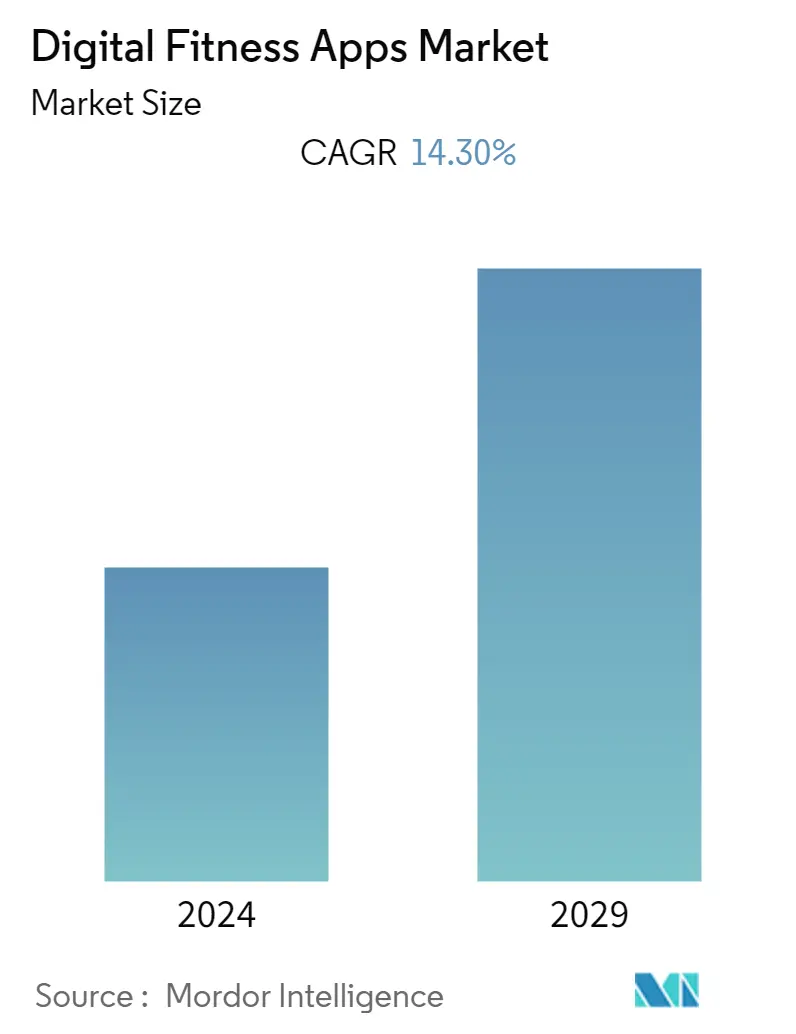
| Study Period | 2019 - 2029 |
| Base Year For Estimation | 2023 |
| Forecast Data Period | 2024 - 2029 |
| CAGR | 14.30 % |
| Largest Market | North America |
| Market Concentration | Low |
Major Players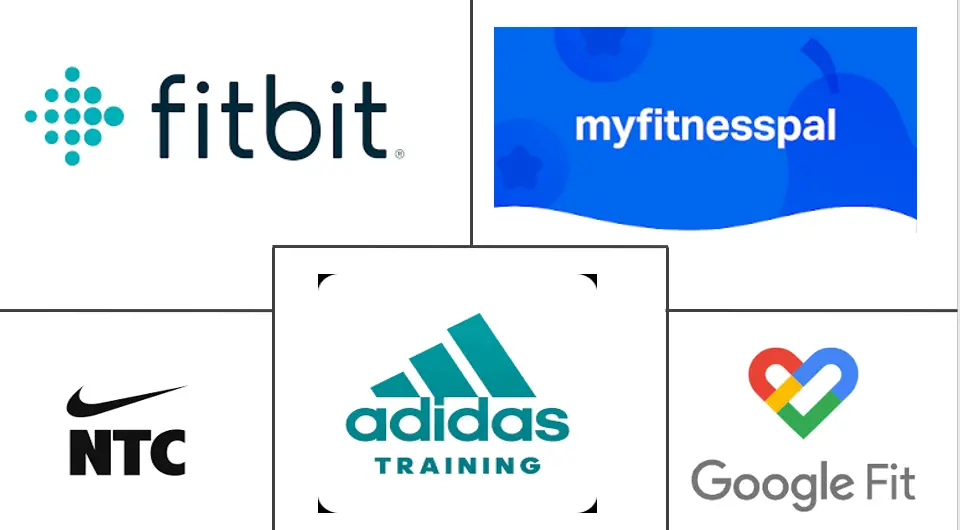
*Disclaimer: Major Players sorted in no particular order |
Digital Fitness Apps Market Analysis
The Digital Fitness Apps Market is expected to grow at a CAGR of 14.3% for the next five years. This can be attributed to the increase in demand for in-app purchases and the dependence of global digital lifestyles on adopting mobile apps. The increased emphasis on maintaining a healthy lifestyle mainly generates the market for fitness apps.
- The market is expanding due to rising smartphone usage globally and rapid technological advancement. The industry is also being expanded by rising data usage, the widespread use of the internet, and a rise in promotional offerings such as subscription discounts. Due to information technology improvements, the fitness industry's operating model is about to change rapidly in the forecast period.
- The fitness apps use emerging technologies for artificial intelligence, machine learning, and several new innovative technologies that track the users' daily routine and provide them with a customized diet, workout, walking, and sleep cycle plans without any machine or equipment. The program keeps an eye on human activity 24/7. Thereby, it is the most effective way of tracking health conditions without much human intervention.
- A typical fitness app gathers information from many wearable gadget sensors. Some sensors are worn on the user's wrist, while others are portable and fit in their pocket. Additionally, the company that created the fitness app allows users to add data to the app manually. Hackers can acquire confidential information like credit or debit card numbers if they get access to the device.
- At present, people around the world have become much more health conscious, especially after the Covid-19 pandemic. Also, obesity and weight gain are causes of concern for the young generation due to improper eating habits, junk food intake, and adverse work-life stress. Newly developed fitness apps concentrate on weight loss tracking measures and provide mental health solutions. That is why fitness apps are largely adopted globally, and the market is expected to witness growth in the coming years.
- During the adverse phase of the pandemic, there was a global state of lockdown. gyms and fitness studios had no choice but to enhance their online presence while the building was under lockdown. COVID-19 enhanced users' transition from conventional studios and gyms to virtual training platforms, quickly increasing the number of fitness app downloads and subscriptions.
Digital Fitness Apps Market Trends
This section covers the major market trends shaping the Digital Fitness Apps Market according to our research experts:
Rapid Digitalization Aids Market Growth
- Numerous sectors have seen significant digital developments since the start of the twenty-first century. Most businesses are benefiting from constantly developing technology, from e-commerce to healthcare. One of the latest entrants is the fitness sector. In the past, it has prioritized highly customized face-to-face encounters, putting technologies behind. Gym-goers and health-conscious people are further exploring the benefits of digitalization and anticipating the service providers to do the same.
- The increasing mobile app business is hardly surprising, given that there are more than 6.3 billion smartphone users worldwide. Since smartphone penetration and app usage are both still growing substantially, it does not appear that it would slow down anytime soon. Mobile applications have significantly changed our everyday lives. Consequentially the adoption of fitness apps is also increasing.
- Moreover, mobile phone apps can be used anywhere, and the rising adaptation of these fitness apps is increasing due to the better area coverage and internet network infrastructure. According to datareportal, internet users worldwide have reached 5.07 billion, or 63.5% of the world's population. The rising use of smartphones, tablets, wearable technologies, and high-speed internet access among the general population would increase the market for fitness apps throughout the forecast period.
- Utilizing wearable wellness-tracking technology is just one example of a current trend in the fitness sector that gives us access to a vast amount of user data. Modern fitness apps integrate artificial intelligence and machine learning to access real-time data from users to track their activities every moment. Also, fitness centers have the chance to attract new clients due to AI-based fitness applications.
- With over 18 million downloads last year, Planet Fitness was the US's most widely used health and fitness app. Sweatcoin, a sports and activity monitoring software, came in second place with almost nine million downloads. During the study period, the meditation and mental health app Calm had 8.8 million downloads nationwide, placing it third among health apps. Flo was downloaded 7.2 million times by United States users in the studied year, despite the controversy surrounding period tracking mobile applications data sharing and privacy settings in the wake of the Supreme Court overturning Roe v. Wade.
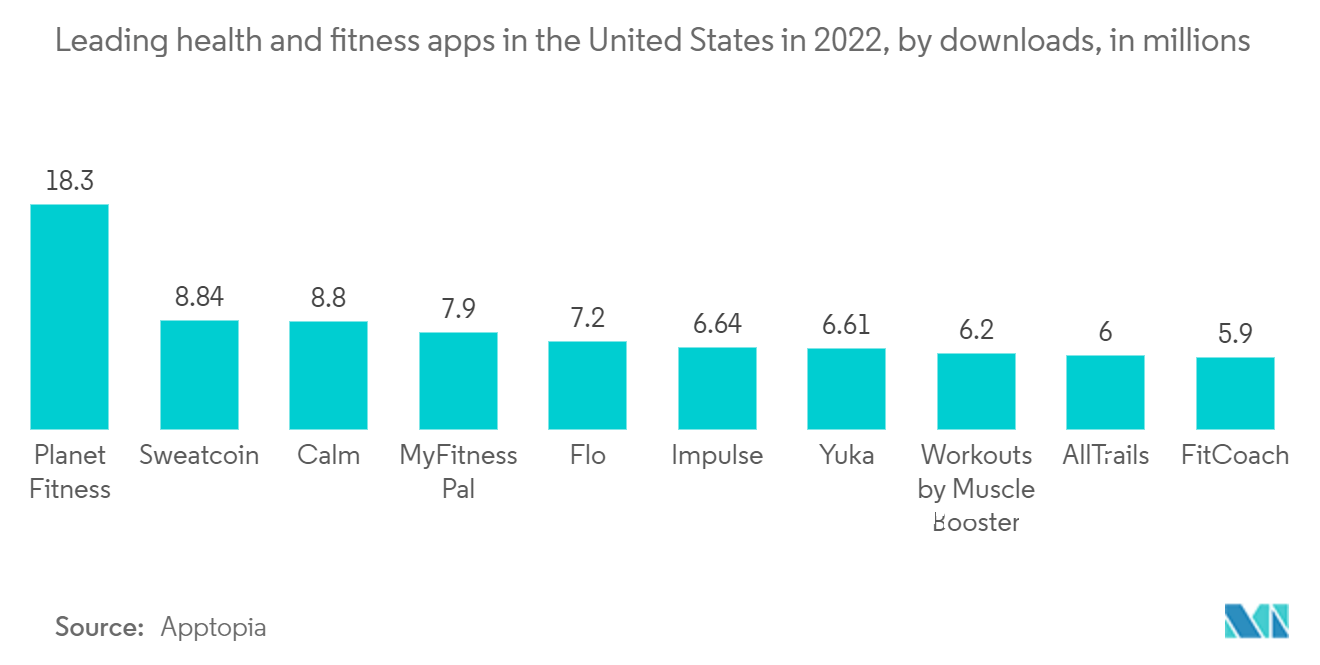
North America is Expected to Witness More Growth
- In recent years, North America has had a substantial market share. The rise is also anticipated to continue during the projection period. Numerous elements, including a rise in the number of chronic diseases, a quick increase in smartphone usage, and an expansion of coverage networks, contribute to digital fitness growth in North America.
- The United States is regarded as the global center for technology. With constant innovation and the growing trend of using technologically advanced apps that can have an impact over the long term, the nation consistently works to build the newest technology and applications quickly. North America has the highest rate of adoption of mobile applications across the world, including digital fitness app adoption.
- The existence of major market participants like Fitbit, Nike, Inc., Azumio, and Headspace are crucial drivers supporting this region's industry. Notably, North American businesses are incorporating artificial intelligence (AI) more rapidly to monitor and track the activity on a real-time basis on their apps. It is anticipated that the demand for these fitness apps will increase even more due to the ongoing introduction of new technologies and the rising usage of specific features in health apps.
- Furthermore, the demand for digital fitness apps in the area is accelerating because of encouraging government initiatives. The United States government is investing significantly to create a new public health informatics and digital health program and has persisted in emphasizing the importance of innovation and digital health as key components of a strong healthcare system.
- Moreover, the industry in the region is also being driven by chronic health issues that the elderly population faces. According to research by the National Association of Chronic Disease Directors, nearly 60% of Americans have at least one chronic illness. As the American population ages, more persons are classified as having a "high risk" of developing certain chronic illnesses. These fitness apps help them keep constant contact with doctors, trainers, dietitians, and mental health mentors.
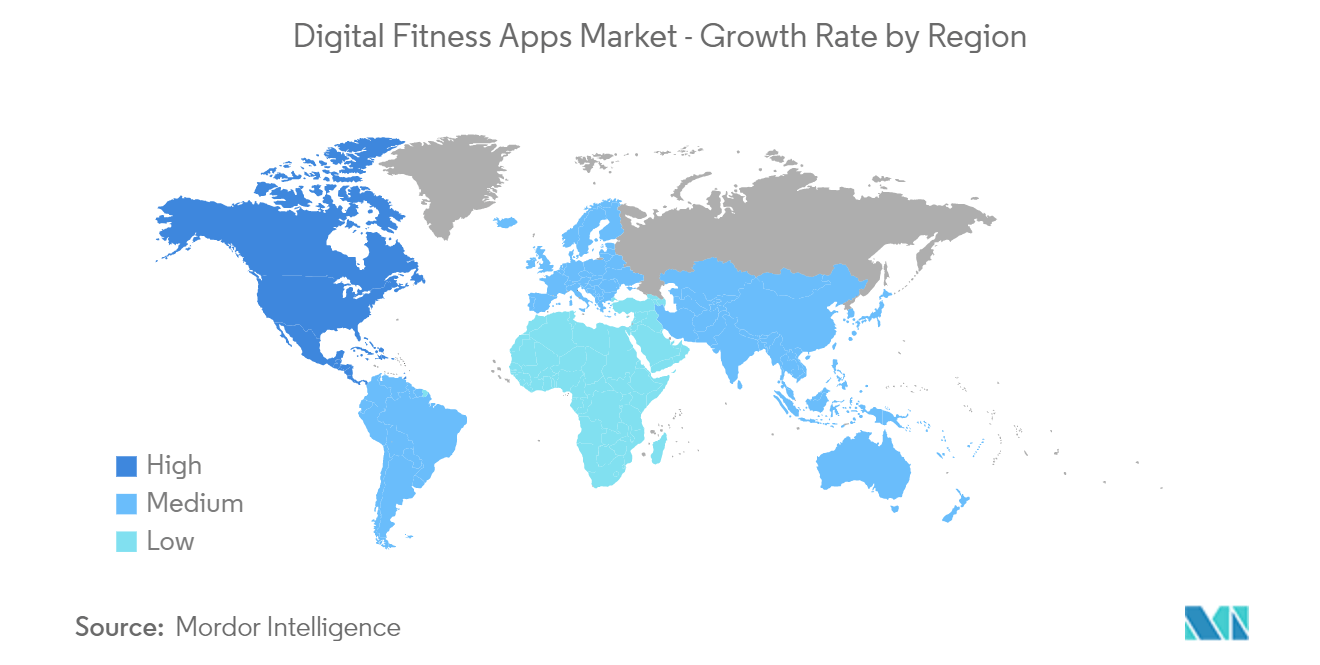
Digital Fitness Apps Industry Overview
The Digital Fitness Apps Market is highly fragmented as it currently consists of several large market players. Many key players in the market are in constant efforts to bring advancements. A few prominent companies are entering into collaborations and expanding their global footprint in developing regions to consolidate their positions in the market. The major player in this market includes Adidas, Nike, Firbit Inc, MyFitnessPal Inc., and Google.
In November 2022, Google unveiled that the Google Health Connect app is currently available in beta on Playstore. Health Connect was created to centralize access to health and fitness data from many qualified apps. More than ten health and fitness apps, including MyFitnessPal, Oura, and Peloton, are introducing integrations with Health Connect. Developers no longer need to create a brand-new integration because of Health Connect. According to Google, adding fresh data from Health Connect is required to develop an integration with a new app.
In September 2022, Fitbit redesigned its app in the style of Material You for the fall release of the Sense 2 and Versa 4. In advance of its arrival, Fitbit brought along its most cutting-edge smartwatches and fitness trackers to demonstrate. The business also previewed a revamped Fitbit app with Material You-inspired graphics. Along with the debut of the new hardware, a new app is planned.
Digital Fitness Apps Market Leaders
-
Adidas
-
Nike
-
Firbit Inc
-
Google
-
MyFitnessPal Inc.
*Disclaimer: Major Players sorted in no particular order
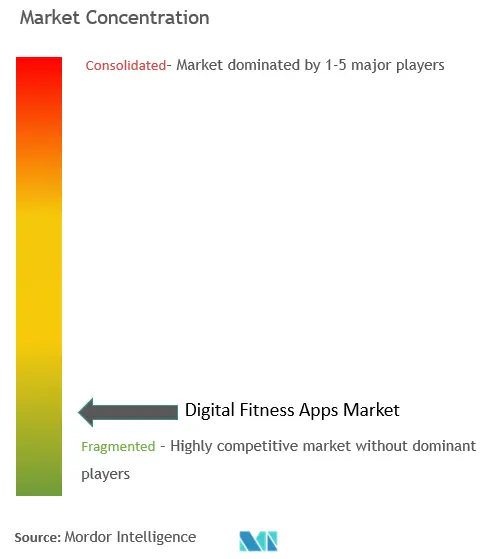
Digital Fitness Apps Market News
- In November 2022, Headspace Health, the provider of the world's most user-friendly, comprehensive digital mental health platform, unveiled a unique product experience that combines the top-tier coaching, therapy, and psychiatry services provided by Ginger with Headspace's world-class meditation and mindfulness offerings. The new experience offers employees a centralized location for high-quality mental health and well-being support and an underpinning platform that eases employers' complexity and administrative strain.
- In June 2022, Flo Health introduced Flo for Business, an inclusive strategy for employees' women's health. Flo for Business, accessible in 245 countries and 20 languages, aims to inform and empower staff members about monitoring their periods, ovulation, and general reproductive health. For every stage of life, a new employee benefit offers comprehensive, science-based assistance on various reproductive health subjects.
Digital Fitness Apps Market Report - Table of Contents
1. INTRODUCTION
- 1.1 Study Assumptions and Market Definition
- 1.2 Scope of the Study
2. RESEARCH METHODOLOGY
3. EXECUTIVE SUMMARY
4. MARKET INSIGHTS
- 4.1 Market Overview
-
4.2 Industry Attractiveness- Porter's Five Forces Analysis
- 4.2.1 Bargaining Power of Suppliers
- 4.2.2 Bargaining Power of Consumers
- 4.2.3 Threat of New Entrants
- 4.2.4 Threat of Substitute Products
- 4.2.5 Intensity of Competitive Rivalry
- 4.3 Impact of COVID-19 on the Industry
5. MARKET DYNAMICS
-
5.1 Market Drivers
- 5.1.1 Significant Smartphone Penetration and Internet Coverage
- 5.1.2 Increased Investment on Digital Health
-
5.2 Market Restraints
- 5.2.1 Risk of Data Security Threats
6. MARKET SEGMENTATION
-
6.1 By Type
- 6.1.1 Fitness Apps Tracking Fitness Achievements
- 6.1.2 Nutrition Apps
- 6.1.3 Meditation Apps
- 6.1.4 Contraception and Fertility Apps
- 6.1.5 Medication Checker Apps
- 6.1.6 Others Mindfulness Apps
-
6.2 By Geography
- 6.2.1 North America
- 6.2.2 Europe
- 6.2.3 Asia Pacific
- 6.2.4 Latin America
- 6.2.5 Middle East and Africa
7. COMPETITIVE LANDSCAPE
-
7.1 Company Profiles
- 7.1.1 Adidas
- 7.1.2 Nike
- 7.1.3 Firbit Inc
- 7.1.4 MyFitnessPal Inc.
- 7.1.5 Google
- 7.1.6 Headspace Inc
- 7.1.7 Flo Health Inc
- 7.1.8 Strava, Inc.
- 7.1.9 Sworkit Health
- 7.1.10 Noom, Inc.
- 7.1.11 Azumio, Inc
- 7.1.12 Peloton Interactive, Inc.
- 7.1.13 Applico Inc
- 7.1.14 Famometer
- *List Not Exhaustive
8. INVESTMENT ANALYSIS
9. FUTURE TRENDS
** Subject To AvailablityDigital Fitness Apps Industry Segmentation
The Digital Fitness & Well-Being Apps provide health and fitness tools for identifying, tracking, assessing, and comparing fitness progress. They also include diet and nutrition applications, which enable users to track and evaluate their eating habits to make better nutritional and health decisions. Additionally, contraception and fertility applications improve users' knowledge, offer monitoring features, and give them instructions on themes like self-care, family planning, and birth control. Apps for meditation include those that support users' ability to maintain composure under pressure, manage their emotions, and focus on the present moment.
The Digital Fitness Apps Market is segmented by Type (Fitness Apps Tracking Fitness Achievements, Nutrition Apps, Meditation Apps, Contraception and Fertility Apps, and Medication Checker Apps) and Geography (North America, Europe, Asia Pacific, Latin America, and the Middle East and Africa). The market sizes and forecasts are provided in terms of value (USD million) for all the above segments.
| By Type | Fitness Apps Tracking Fitness Achievements |
| Nutrition Apps | |
| Meditation Apps | |
| Contraception and Fertility Apps | |
| Medication Checker Apps | |
| Others Mindfulness Apps | |
| By Geography | North America |
| Europe | |
| Asia Pacific | |
| Latin America | |
| Middle East and Africa |
Digital Fitness Apps Market Research FAQs
What is the current Digital Fitness Apps Market size?
The Digital Fitness Apps Market is projected to register a CAGR of 14.30% during the forecast period (2024-2029)
Who are the key players in Digital Fitness Apps Market?
Adidas, Nike, Firbit Inc, Google and MyFitnessPal Inc. are the major companies operating in the Digital Fitness Apps Market.
Which region has the biggest share in Digital Fitness Apps Market?
In 2024, the North America accounts for the largest market share in Digital Fitness Apps Market.
What years does this Digital Fitness Apps Market cover?
The report covers the Digital Fitness Apps Market historical market size for years: 2019, 2020, 2021, 2022 and 2023. The report also forecasts the Digital Fitness Apps Market size for years: 2024, 2025, 2026, 2027, 2028 and 2029.
Digital Fitness Apps Industry Report
Statistics for the 2024 Digital Fitness Apps market share, size and revenue growth rate, created by Mordor Intelligence™ Industry Reports. Digital Fitness Apps analysis includes a market forecast outlook to 2029 and historical overview. Get a sample of this industry analysis as a free report PDF download.



